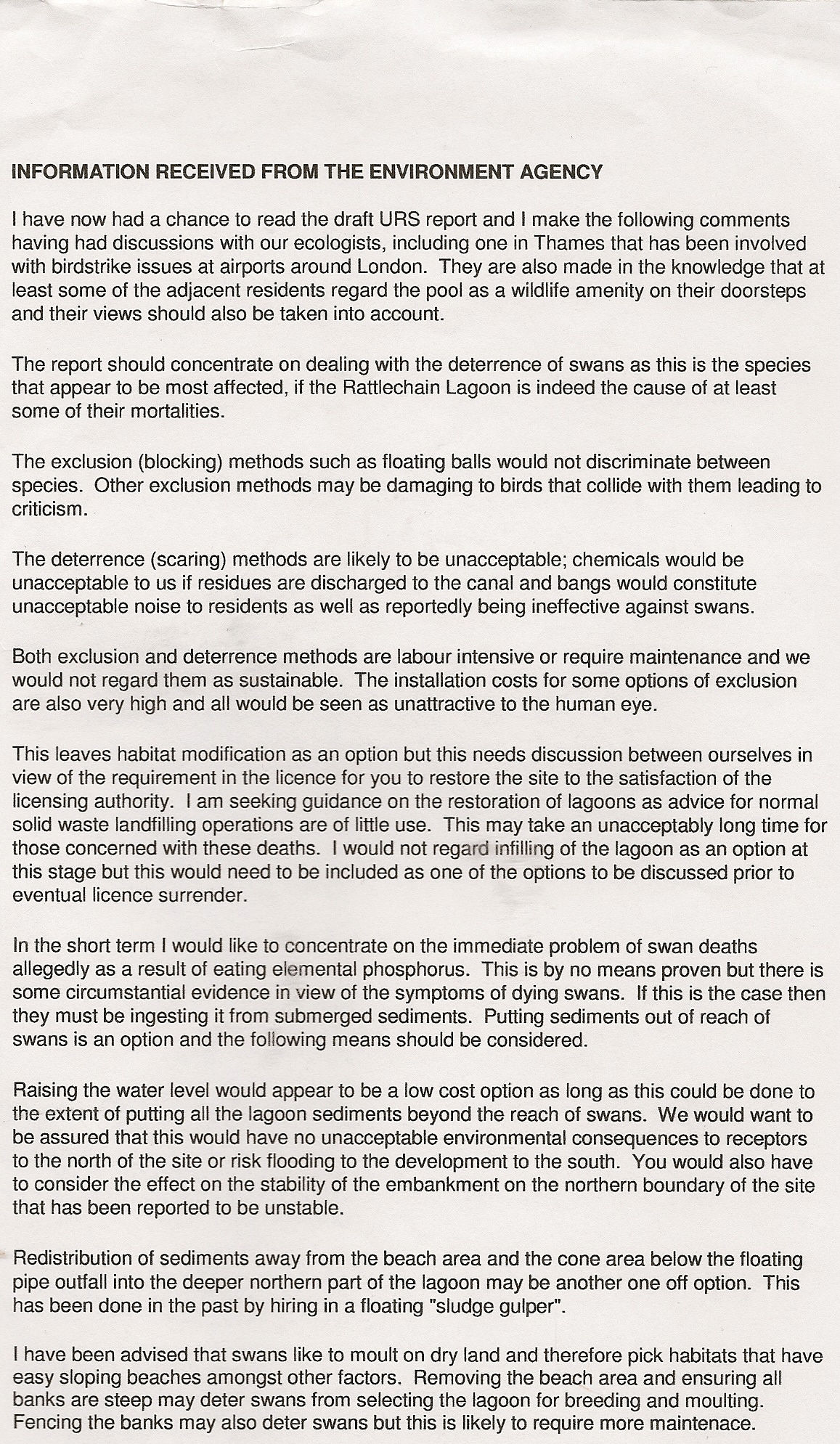How do you solve a problem like “the mere”?- Restoration options for the Rattlechain Sludge lagoon.
WHAT DID WE ASK?
(i) I am requesting whether you hold a copy of the documents CL Associates, “restoration Options for Rattlechain Sludge Lagoon, Oldbury, West Midlands, dated July 1996, reference no 6871 and
URS Corporation ltd, Options Study for restoration of the Rattlechain sludge lagoon, Ref 1064/44557-020-787/JC/RC, dated 20 March 2002?
If you do I would request an electronic copy.
(ii) If you do not hold these, can you confirm if officers at the environment agency concerned with evaluating the best long term sustainable solution for the site have requested to see these documents from the site owners in their endeavors to assess the
“restoration options”?
(iii) Can the Agency confirm if it holds any recorded information- including email discussions with the site owners, concerning that one option for restoration is the laying of a geotextile membrane, followed by capping with gravel and hardcore imported onto the
site?
WHY DID WE ASK THIS?
We were aware of these two reports concerning “restoration options” that had been carried out for Albright and Wilson and Rhodia. We had asked Rhodia if they could provide us with a copy. They did not bother to reply.
It is quite clear that the laying of a geotextile membrane became the favoured remediation option, given that it is the cheapest option, not involving the removal off site of highly toxic contaminated material. Obtaining these documents would shed further light on what AW/Rhodia knew about the risks of white phosphorus and the potential levels in the sediment that may contradict the levels found in the HPA study which we do not believe to be credible.
Other p4 contaminated sites have followed a similar pattern of laying geotextile membranes. The identification of this prefered option, back in 1996 and 2002 would confirm that the current exercise which Rhodia claim to be about “protecting birds” is a total fallacy and a PR lie- one based upon the fact that Swanwatch have uncovered the link between their activities and bird deaths on the site.
WHAT DID THEY KNOW?
A response was received.
- The Environment Agency does not hold copies of either of these documents.
- The Environment Agency has not formally requested copies of these documents from the site owner. We are evaluating the option currently being considered by the site owner as related in (iii) below.
- The only recorded information we hold are the same documents that the site owner has already directly supplied to yourself. These are:(a) Rattlechain Lagoon, Bird Management Plan, 26th November 2008 FINAL, Issue No 3, 49309240. In Appendix B you will find a copy of the Environment Agency’s response to the site owner’s consultation on Issue No 1 of the Bird Management Plan. (b) Rattlechain Lagoon, Geofabric Field Trial Report, 22nd April 2010, Final Issue No 49309316/.
- There are no e-mail discussions with the site owners in relation to this option.” THIS RESPONSE IS SHOWN BELOW- BUT THERE IS NO NAME ATTACHED TO THE AUTHORSHIP, THOUGH WE KNOW THAT THEY WERE WRITTEN BY THEN ENVIRONMENT MANAGEMENT TEAM LEADER DAVE WHITFORD.
NB note the comments
- In reference to the now proven link between white phosphorus and bird deaths on the site “…they must be ingesting it from the submerged sediments.”
- “Redistribution of sediments away from the beach area and the cone area below the floating pipe outfall into the deeper northern part of the lagoon may be another one off option. This has been done in the past by hiring a floating “sludge gulper”
WHAT DOES THIS MEAN?
The EA are reviewing the best long term sustainable option for the restoration of the lagoon, yet are not in possession of two documents which were compiled about this very purpose. Nor have they asked to see them.
Tying this geotextile membrane scheme into “bird management” suits Rhodia’s new narrative. The EA were not concerned with white phosphorus in the lagoon sediments when the company was still disposing of waste into the lagoon. They were also not concerned with this highly toxic material being redistributed by the “sludge gulper”.
Like Rhodia, the EA are happy for this toxic material to be swept under the carpet.

